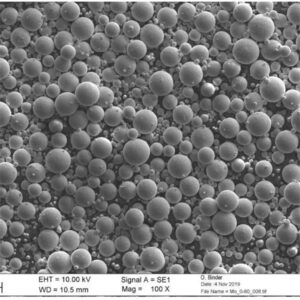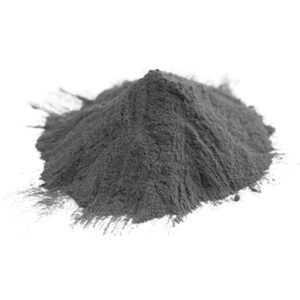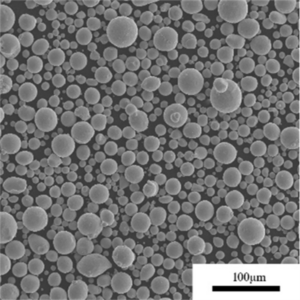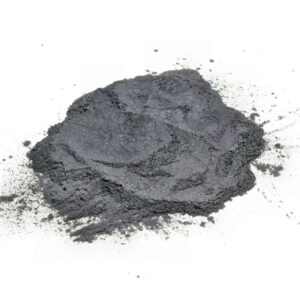개요 가스 분무 금속 분말
가스 분무 금속 분말은 용융 합금 공급 원료를 고속 불활성 가스 제트로 분무하여 생산되는 금속 미립자 물질을 말합니다. 이는 적층 제조, 금속 사출 성형 및 기타 응용 분야에 이상적인 구형 형태를 부여합니다.
가스 분무 기능:
- 입자 모양, 크기 분포에 대한 탁월한 제어
- 티타늄, 알루미늄을 포함한 반응성 합금에 적용 가능
- 고급 공정을 위한 고순도 출발 물질 제공
- 열간 등방성 프레스, 열처리를 위한 맞춤형 분말
- 정밀한 반복 가능한 파우더 특성 지원
가스 분무 분말의 구성 옵션, 입자 품질, 사용 용도 및 사양에 대해 자세히 알아보려면 계속 읽어보세요.

가스 분무 금속 분말의 합금 유형
다양한 합금을 기체 분무하여 미세한 구형 분말로 만들 수 있습니다:
| 합금 카테고리 | 재료 | 작곡 |
|---|---|---|
| 스테인리스 스틸 | 304, 316, 17-4PH, 303, 410 | Fe/Cr/Ni + 미량 원소 |
| 공구강 | H13, M2, M4 | Fe + V, Mo, W 탄화물 |
| 코발트 합금 | CoCr, CoCrW, CoCrMo | Co/Cr + 텅스텐/몰리브덴 |
| 니켈 합금 | 인코넬 625 및 718 | Ni/Cr/Fe/Mo |
| 티타늄 합금 | Ti-6Al-4V, Ti-6242 | Ti/Al/V/Sn/Zr/Mo |
표 1: 가스 분무 분말로 상용화된 합금 시스템 개요
항공우주/바이오메디컬용 특수 적층 제조 및 산업별 합금은 최소 주문 수량 또는 리드 타임이 있을 수 있습니다.
파우더 특성
불활성 가스 원자화를 통해 달성되는 일반적인 입자 특성:
| 특성 | 세부 정보 | 중요성 |
|---|---|---|
| 파티클 모양 | 고도로 구형 | 분말 흐름 및 포장 밀도 개선 |
| 크기 범위 | 10μm ~ 150μm | 최종 사용에 최적화된 제어된 배포 |
| 구성 | 0.5 wt% 이내로 합금 유지 | 기계적 특성 보존 |
| 순도 | 최대 99.9% 달성 가능 | 오염 물질 및 내포물 감소 |
| 표면 산화물 | <50nm 두께의 패시베이션 레이어 | 우수한 분말 재활용성 유지 |
표 2: 가스 분무 금속 분말의 입자 품질 개요
항공우주, 의료, 자동차 및 산업 전반의 인증 요구 사항을 충족하기 위해 반복적으로 생산되는 정밀한 속성.
제조 프로세스
- 불활성 가스 분무의 일반적인 단계:
- 유도 또는 아크 용융은 보호 커버 가스 아래에서 합금 용융을 형성합니다.
- 특수 노즐을 통해 강제 공급되는 고순도 불활성 가스(Ar 또는 N2)
- 용융된 스트림이 미세한 물방울로 분해되어 빠르게 냉각되어 분말로 변합니다.
- 분말은 아래의 수집 호퍼에 침전됩니다.
- 체를 통해 분류하여 분포 정규화
- 보호 환경에서 포장되어 고객에게 배송됩니다.
- 중요한 프로세스 매개변수:
- 노즐 설계 - 입자 크기 분포 관리
- 가스 압력 - 입자 속도와 냉각 속도에 영향을 미칩니다.
- 용융물 붓는 속도 - 크기 분포 모양에 영향을 미칩니다.
- 환경(진공 대 통제된 대기)은 반응성에 따라 달라집니다.
응용 가스 분무 금속 분말
| 애플리케이션 | 혜택 | 예제 |
|---|---|---|
| 적층 제조 | 우수한 파우더 흐름과 포장으로 인한 고밀도 부품 | 항공우주 부품, 의료용 임플란트 |
| 금속 사출 성형 | 작고 복잡한 형상을 위한 우수한 성형성 | 터빈 블레이드, 노즐 구성품 |
| 용사 코팅 | 변형 가능한 입자 충격으로부터의 고밀도 코팅 | 내마모성 표면 |
| 브레이즈 페이스트 | 복잡한 도형 결합 | 열교환기, 전기 접점 |
| 열간 등방성 프레스 | 구형 입자로 인한 폐쇄 문제 최소화 | 주조 터빈 블레이드 통합 |
| 열처리 전구체 | 맞춤형 입자 구조 | 강수량 경화 합금 |
표 3: 가스 분무 금속 분말의 특성을 활용하는 응용 분야 개요
가스 분무가 제공하는 일관성과 순도는 반복성이 중요한 대부분의 첨단 금속 분말 공정에 적합합니다.
사양 가스 분무 금속 분말
가스 분무 분말은 다양한 표준 사양에 따라 검증됩니다:
| 표준 | 설명 |
|---|---|
| ASTM B214 | 광학 현미경을 사용한 균일성 및 위성 부족 검증 |
| AMS 7008 | 불활성 가스 분무 방식을 포함한 항공우주 재료 사양 |
| ASTM F3049 | 적층 제조용 금속 분말의 특성 분석을 위한 표준 가이드 |
| ASTM F3056 | 적층 제조 니켈 합금 분말 사양 |
| ISO 21818 | DMLS/SLM 생산 등급 스테인리스강 사양 |
표 4: 불활성 가스 분무 분말에 일반적으로 적용되는 산업 표준
평판이 좋은 생산업체는 각 파우더 로트에 대한 전체 인증 서류와 테스트 결과를 제공하여 규정 준수를 검증합니다.
공급업체 및 가격
| 공급업체 | 재료 | 표시 가격 |
|---|---|---|
| 샌드빅 오스프리 | Ti 합금, Ni 합금, 공구강 | kg당 $100+ |
| 목수 첨가제 | 스테인리스강, 코발트 합금, Cu | $50 - $150 kg당 |
| 프렉스에어 | Ti 합금, Al 합금, 실리콘 분말 | kg당 $100+ |
| LPW 기술 | 공구강, 스테인리스강, 인코넬 | $50 - $500 kg당 |
| SLM 솔루션 | 맞춤형 합금 개발 | $250+ kg당 |
표 5: 대략적인 가격과 함께 가스 분무 금속 분말을 공급하는 업체 선정
대부분의 공급업체는 2~4주 리드 타임의 표준 합금을 소량으로 제공합니다. 가스 분무 공급업체와 직접 협력하여 맞춤형 배합 및 고유한 입자 최적화도 가능합니다.
장단점 및 대안
| 매개변수 | 가스 분무 | 물 분무 | 플라즈마 원자화 |
|---|---|---|---|
| 파티클 모폴로지 | 고도로 구형 | 더 불규칙한 구형 | 대부분 구형 |
| 입자 크기 분포 | 긴밀한 배포, 맞춤형 | 더 넓은 분포 | 긴밀한 배포 |
| 호환되는 합금 | 대부분의 상업용 합금 | 제한된 합금 | 반응성 금속을 포함한 광범위한 범위 |
| kg당 비용 | 보통 $50-150 kg당 | kg당 $20-100 미만 | kg당 더 높은 $150-500 |
| 생산성 향상률 | 하루 최대 10,000kg 용량 | 매우 높음 > 50,000kg/일 | <하루 1,000kg 미만 |
표 6: 가스 분무와 대체 분말 생산 방법의 비교
가스 분무는 상업적 생산에 적합한 파우더 양을 제공하면서 성능과 경제성 사이에서 최적의 균형을 이룹니다.
제한 사항
- 최소 배치 크기는 기계 설정을 정당화하기 위해 100kg 이상의 재료를 사용해야 합니다.
- 텅스텐과 같은 고융점 합금을 경제적으로 원자화할 수 있는 능력이 제한적입니다.
- 플라즈마 원자화만큼 구형이 아니며 일부 위성을 포함하는 분말
- 진공 플라즈마 대체품보다 약간 높은 산화물 두께
- 턴키 시스템의 경우 약 $1-5백만 달러의 가파른 초기 자본 비용
- 버진 소재에 비해 향상된 파우더 취급/보관이 필요합니다.
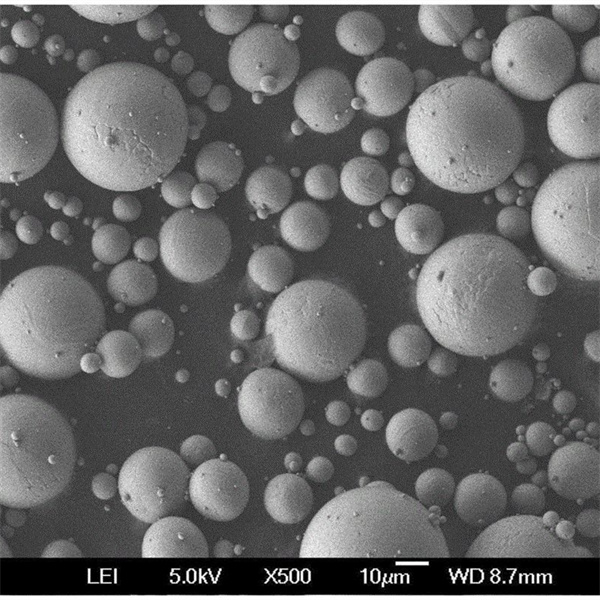
자주 묻는 질문
Q: 부품 생산 시 버진 소재에 비해 가스 분무 분말을 사용하면 어떤 이점이 있나요?
A: 가스 분무 분말은 우수한 일관성과 반복성을 제공합니다. 처음부터 분말 형태와 입자 구조를 엔지니어링하면 항공우주 및 의료 분야에서 가장 높은 산업 요구 사항을 충족하는 인증된 부품을 생산하는 성숙한 공정을 구현할 수 있습니다.
Q: 가스 분무 분말을 취급할 때 어떤 주의 사항이 필요한가요?
A: 미세 금속 물질은 산화되기 쉬우므로 불활성 보관 및 취급 프로토콜을 권장합니다. 여기에는 폭발, 흡입 또는 오염 위험을 최소화하기 위해 습기가 제어되는 아르곤 충전 글러브 박스 및 개인 보호 장비를 착용하는 작업자가 포함됩니다. 물이나 유기 화합물과의 접촉을 절대 허용하지 마세요. 현지 규정이 적용될 수 있지만 특별한 시설 공사가 반드시 필요한 것은 아닙니다.
Q: 가스 분무 분말로 로트 간 어느 정도의 반복성을 기대할 수 있습니까?
A: 평판이 좋은 생산업체는 배치 간 ±10% 이내의 파우더 분포를 보장합니다. 허용 가능한 성분 허용 오차가 엄격한 경우 동일한 파우더 공급업체라 하더라도 사소한 변화는 표준 관행으로 재최적화를 보장합니다. 분석 문서 일관성 인증서.
Q: 사용하지 않은 가스 분무 분말은 얼마나 오래 보관할 수 있나요?
A: 파우더는 극한 온도를 피하여 밀폐된 용기에 보호용 아르곤으로 보관하는 것이 가장 좋습니다. 산소와 습기를 최소화하여 30°C 및 50% 상대 습도 이하로 유지하면 파우더의 흐름과 재사용 특성을 유지하기 위해 글러브 박스에서 교체 주기가 필요하기 전까지 수개월 동안 지속됩니다.
Q: 파우더 공급업체는 부품 검증 및 인증을 위해 어떤 기술 지원을 제공하나요?
A: 평판이 좋은 공급업체에는 재료 과학자와 검증 담당자가 있어 테스트 프로세스를 통해 부품 구매자에게 적용 지침을 제공하고 분말을 인증하기 위해 부품 구매자와 소통할 수 있습니다. 이들은 더 까다로운 응용 분야에서 재료의 사용을 확대하기 위해 규제 표준을 충족하는 반복성을 입증하기를 원합니다. 기존 공급업체의 상세한 서류 작업과 프로토콜을 기대합니다.

